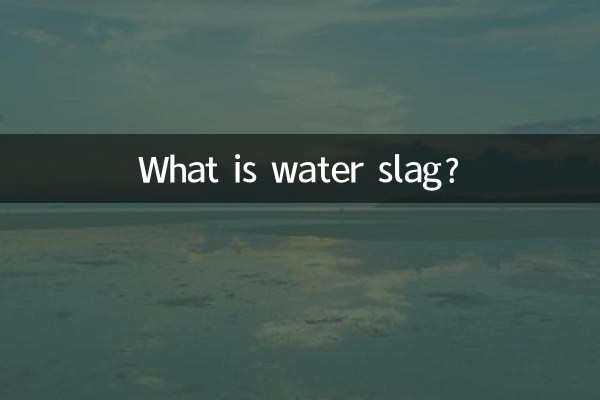What is water slag?
Among the hot topics on the Internet in the past 10 days, the word "water slag" frequently appeared in discussions in the fields of environmental protection, industrial production and material science. Many people are curious about its exact meaning and uses. This article will provide an in-depth analysis of the definition, sources, uses and related data of water slag to help readers fully understand this material.
1. Definition of water slag

Water slag, also known as blast furnace slag or metallurgical slag, is a by-product produced during the steel smelting process. It is mainly formed from molten slag produced during iron-making in a blast furnace and cooled by water quenching. It has the characteristics of fine particles and porous particles. The main components of water slag include silicates, aluminates and calcium and magnesium compounds.
2. Source of water slag
Water slag mainly comes from the steel smelting process. The following are the key links in its production:
| production link | describe |
|---|---|
| Blast furnace ironmaking | Iron ore reacts with coke in a blast furnace to produce molten iron and molten slag. |
| water quench cooling | Molten slag is rapidly cooled by high-pressure water flow to form granular slag. |
| Collection and processing | After the water slag is collected, it goes through processes such as drying and screening and is used for different purposes. |
3. Uses of water slag
As an industrial by-product, water slag has a wide range of uses, especially in the fields of construction and environmental protection. Here are its main uses:
| Application areas | Specific applications |
|---|---|
| building materials | As cement mixture, concrete aggregate or road base material. |
| Environmentally friendly materials | Used for wastewater treatment, soil improvement or heavy metal adsorption. |
| agricultural applications | Use as a soil conditioner or fertilizer additive to improve soil structure. |
4. Physical and chemical properties of water slag
The physical and chemical properties of water slag determine its application scope. The following are its main property data:
| nature | value/description |
|---|---|
| density | 2.8-3.0 g/cm³ |
| particle size | 0.1-5mm |
| Main chemical components | CaO (35-45%), SiO₂ (30-40%), Al₂O₃ (10-15%) |
| activity index | ≥70% (for cement mixture) |
5. Market status of water slag
According to recent market data, the demand for water slag is increasing year by year, especially driven by green building and circular economy policies. The following is some market data:
| area | Annual output (10,000 tons) | Main applications |
|---|---|---|
| China | 280 million | cement, concrete |
| Europe | 120 million | Environmentally friendly materials, construction |
| North America | 90 million | Roadbed materials, agriculture |
6. Future development trends of water slag
With the improvement of environmental protection requirements and the emphasis on resource recycling, the application prospects of water slag will be broader. Possible future development directions include:
1.High value-added utilization: Develop the application of water slag in high-end building materials and functional materials.
2.Environmental protection technology upgrade: Optimize the water slag treatment process to reduce energy consumption and environmental pollution.
3.policy support: Governments of various countries may introduce more policies to encourage the recycling of water slag.
Through the above analysis, we can see that water slag is not only an industrial by-product, but also a resource with important economic value and environmental significance. As technology advances, its application potential will be further unleashed.

check the details

check the details